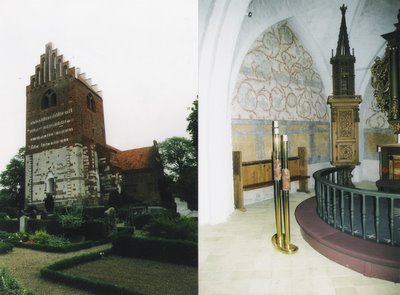
If Candlemas day be fair and bright
Winter will have another flight
But if Candlemas day be clouds and rain
Winter is gone and will not come again.
Danish: Kyndelmisse, English: Candlemas,
Latin: Missa Candelarum.
Denmark:
Kyndelmisse was in the Catholic period a celebration of Mary’s purification 40 days after the birth of Christ. Before the reformation the day was used for candle light processions and consecration of those wax candles, which had to be used in the church the following year. In 1770 the Secretary of the Danish Cabinet, minister J.F. Struensee abolished Kyndelmisse as Holy Day together with a couple of other Holy days in Denmark. Even though February 2. for over 200 years has had no official status in Denmark, there are still today several churches marking Kyndelmisse with special candle services and musical services.

The word "KANDELABRIS" carved in runes in chorus.
Mosbjerg Church, North Jutland (try to enlarge picture)
Candle celebrations can be traced back to the 6th century. It was a Christian feast, and the feast of lighted candles is mentioned by Bede, but like so many other holy days the candle celebrations have their roots in folklore. The celebration of Kyndelmisse is the celebration of Midwinter , and February 2. was often seen as the turning point of winter, from where we go towards brighter times – towards spring and summer. In the Catholic church are still Candlemass celebrations with consecration of wax candles and candle light processions in the honour of Virgin Mary.

Newly ploughed field.
Folklore:February 2. was an important day. People reckoned that winter had now half gone. In western Europe this was the time for preparing the fields for the first plant. There was a tradition for a ritual midwinter ploughing , where a young girl went behind the horses and a young guy worked the plough. This was supposed to give good crops. The fields were purified and offerings were made. In England a medieval Anglo Saxon plough charm was said by the farmer while cutting the first furrow:
Whole be thou Earth
Mother of men
In the lap of god
Be thou as growing
Be filled with fodder
For fare –need of men.

When it snows on Kyndelmisse spring will arrive early.
Weather signs were read for February 2., some are similar in various European countries:
A green Kyndelmisse gives a cold Easter.
A dark Kyndelmisse makes the farmer a squire.
If it snows on Kyndelmisse spring will arrive early.
As long as the lark sings before Kyndelmisse, as long she has to cry after Voldermisse (May 1.)
If the lark is heard for the first time on Kyndelmisse-day spring will arrive early.
If a hedgehog can see his own shadow on Kyndelmisse winter will last still 6 weeks.(This is a sign of high pressure, which will take some time to disappear.)
Kyndelmisse-thaw is as good as 100 loads of hay.
In former times people in Jutland said that if the wind on February 2. was so strong that 18 bitches could not hold on to the 19th bitch, then spring would arrive early. On Zealand they said the quite opposite. If it was possible on Kyndelmisse-day to put a wisp of straw outside without it blowing away, then spring was just around the corner.

Kjørmes is an old Danish expression for Kyndelmisse, and the day is often called "Kjørmes-Knud", which refers to that February 2. was considered the coldest day of the year. "Kjørmes-Knud" means hard frost, as if the winter has turned into a knot of frost = a chilblain.
In folklore are descriptions of “Kjørmes-Feast” on February 2., a feast like many others in the peasantry, where everyone brought food and drink. On this day they had pancakes and drank beer or snaps. Other dishes were cabbage in white sauce with pork, brawn and sausages.
People had to eat pork in order to prevent hunger, and it was furthermore good for back pain. It was also a good advice to eat some of the Christmas bread, since it was said to ease the pain from a headache or a viper bite. The tradition of eating pancakes might originate from a pagan tradition of worshipping the sun and the light in spring; the pancake being round and yellow like the sun.

Huldremose (Moor of the Wood Nymph) , DjurslandCeltic:February 2. is halfway between the Winter Solstice and the Spring Equinox and signals the beginning of spring in the Celtic calendar. It was called Imbolc in pre-Christian times, meaning “in the belly” of the mother, because seed were starting to germinate and the sheep were pregnant. This time was sacred to Brigid the Earth Mother and goddess of fire, water, healing, poetry and fertility.
Imbolc was a fire festival celebrated with hilltop bonfires. It was also the day when people stopped using candles indoors because the days were getting longer. The fields were purified and blessed with candle light processions, and offerings were made to the goddess. Yuletide greens were burned and people cleaned and purified their homes. This custom lingers on as Spring cleaning.
Brigid was transformed into the Christian St. Brigit, who supposedly was converted from Druidism by St. Patrick. She remained associated with miracles and fertility. Originally Imbolc was celebrated on February 1., but the Catholic church transformed it into Candlemas on February 2.
photo: grethe bachmann












